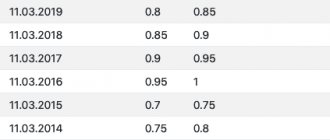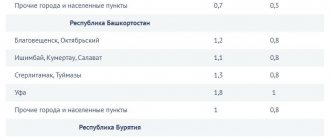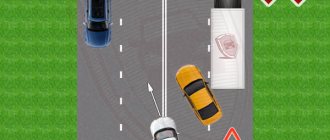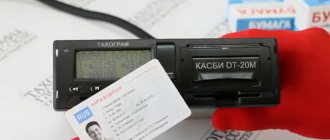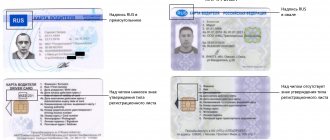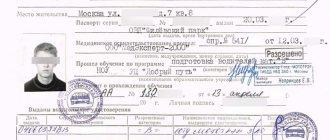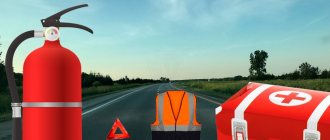Operating instructions for the installed tachograph
Motorists should know the rules for using a tachograph device. They are quite easy to remember, but there are a number of actions in which you cannot make mistakes. Here's how to use a tachograph correctly: you need to install the card before you start driving, before starting the car. First, let's figure out how to do this. The procedure is as follows:
- The card is inserted so that the chip is facing up, and the driver information and photo are facing in the opposite direction from the entrance to the device.
- The card is inserted into a hole located on the left side of the device.
- Most tachograph models require the card to be inserted slowly, as they often automatically withdraw the document.
- In domestic models, which are designed more simply, the card must be smoothly pressed into the device until a specific click is heard.
Then the owner initialization and configuration procedure occurs. To remove the card, you will need to press the button located under the slot.
The activation procedure goes like this:
- After inserting the card, use the specially designed buttons to select the “Enter PIN code” action;
- then the corresponding numerical value is entered and “OK” is pressed;
- if the code is entered correctly, a greeting will appear on the screen, and the last date of use of the device may also be displayed for a few seconds;
- the tachograph will ask the question “Did it correctly identify the card owner?”, to which the driver must click “Yes”;
- the information is then stored on the chip;
- As confirmation, a message will appear on the display indicating that the device is ready for use.
To print the information you will need:
- In the device menu, select the “Print” action.
- Then click “OK”, thereby confirming your intention to print the summary.
- Select the period for which information is needed; most often the request is made per day.
- It is also possible to manually enter the date.
- Then the device system will ask where to display the data, on a receipt or on a monitor.
- After confirming the required action, you can view the performed manipulations on the display or print them. In the second case, a check with information will appear from a special hole.
Time relax
The driver must rest sufficiently to ensure safe driving on the highway. It is this axiom that formed the basis of the AETR rules regarding rest periods during transport, recorded by a tachograph. The clauses of the agreement clearly state what exactly is considered rest and what is not. And how much time, both during the day and the week, should the driver spend not behind the wheel.
So how long should a driver rest according to the tachograph? The rules indicate the current standards.
- The driver is required to rest for eleven hours after each daily nine-hour driving period. This rest period must be continuous.
- The daily rest time can be reduced by two hours, but not more than three times in one week and provided that compensation is provided the following week.
- Subject to an increase of an hour, the driver’s daily rest period is allowed to be divided into two or even three unequal periods of time.
- If the daily rest period is divided, the duration of the longer interval cannot be less than eight hours.
- After six periods of daily driving, the driver is given a weekly rest period of at least 45 hours.
- A weekly rest period is allowed to be granted at the end of the calendar week, if before that the driver’s working time has not exceeded the sum of six daily driving periods.
- For regular international transport, such a rest period is provided on the twelfth day.
A reduction in the rest period provided at the end of the week is permissible up to 36 hours.
But to comply with this rule, two conditions for a rest stop must be met:
- in the locality where the vehicle is registered,
- at the driver's place of residence.
Unused weekly rest is compensated, maximum, in the third week after the one in which the reduction in rest time occurred.
If the weekly rest period falls on two consecutive weeks, then it is allowed to be attached to one of them.
The time compensated for the previously unused period must be added to another rest period.
It lasts at least eight hours and is carried out by the driver where his vehicle is registered or where he lives.
If the car is driven by two drivers, then within 36 hours each of them is entitled to a rest period of at least eight hours.
After every 4.5 hours of driving, the driver is entitled to a 45-minute break. It is allowed to be replaced by three 15-minute ones, if at this time the driver is not busy with any other work.
At the same time, the following is not considered such work:
- loading,
- expectation,
- driving another car or taking a ferry.
An analysis of these standards shows that the driver can count on the employer to provide him with the opportunity to rest for at least 11 hours - twice a week, and with subsequent compensation - 10.
You can add an hour and break your 12-hour rest into two or three periods. In this case, the largest of them should be equal to 8 hours.
You can also divide the 45-minute break every 4.5 hours into 15-minute intervals at different times.
Ideally, at the end of each week, the driver should count on 45 hours of rest. In some cases - 24, with compensation
How to use the tachograph
Where to get a driver card for a tachograph
So, once you are in the driver’s seat, you need to install the card in the tachograph. The card itself (in most cases) is inserted with the contact pads of the chip facing up.
Next, enter the PIN code; if it is entered incorrectly more than three times, the individual driver card will be blocked until the PUK code is entered correctly, i.e. generally similar to a cell phone SIM card. The need to enter the code is due to protection against possible use of the card by another person (for example, in the event of its theft).
Video - instructions for drivers on how to work with a tachograph:
After successfully entering the code, the driver’s information (full name) will be displayed on the device display. It is necessary to make sure that the device recognizes the card, because The display of driver data confirms successful card identification.
If recognition does not occur, then several options are possible:
- The card is inserted incorrectly (it should be clearly fixed, with a characteristic click);
- The card is faulty;
- The tachograph is faulty.
In case of malfunction, you must contact the appropriate organization within seven days.
Then you need to select the driver operating mode. This is either a rest or work mode. Most often, the tachograph independently sets the current modes, but you need to make sure that they are correct.
After which you can begin to perform your duties - further fixation is carried out by the device independently.
It is worth noting that when the engine is running, the tachograph records the “work” mode (in the case when the engine is running and the driver is resting, it is necessary to set the mode manually), and when the engine is switched off, it is resting. Current modes are displayed on the device screen
When the vehicle starts moving, the device will record this event and display it on the screen.
Completion of a work shift is accomplished by withdrawing your driver's card. To do this, you need to press the corresponding key on the device (or a combination of keys), and the device will “give” the card.
As can be seen from the description, there is nothing complicated in using a tachograph; you just need to be careful and strictly follow the instructions. But on the road you can’t do without these qualities either.
Video - how to use the Shtrikh tachograph:
Breaks between long shifts during work hours
It is not only breaks during the shift itself that are intended to ensure the driver’s recovery after driving a vehicle. It is also important to respect the length of rest periods between long driving intervals.
When recording working hours on a daily basis, the minimum duration of such a period should be 2 times longer than the duration of the shift itself. This time also includes lunch time. With a standard 8-hour work schedule, this makes it possible to start your shift at the same time every day without violating legal requirements.
For summarized recording of working hours, other rules apply:
- 12 hours is the minimum standard break duration between work shifts.
- 9 hours is the minimum for regular urban/suburban routes. Reducing the break to 9 hours is only possible if after the second shift the rest period is at least 2 days.
- 11 hours (no more than 3 times a week before midnight) on intercity routes. If the rest periods between shifts are shortened next week, the driver must be given a break to cover the lost time.
- It is possible to divide the rest time between shifts into parts (the minimum duration of one of the parts is 8 hours).
During the week, the driver is also provided with continuous rest of at least 42 hours + time for rest between shifts. The number of days off should not be less than the number of weeks in a month, therefore during the week the employee must receive at least one day off.
Like breaks during the flight itself, long intervals during which the driver rests are also recorded by the tachograph.
Responsibility for failure to comply with labor requirements
Responsibility for non-compliance with the norms specified in the article is regulated by the Code of Administrative Offenses of the Russian Federation (Article 11.23). Paragraph 3 of this article establishes a fine, the maximum amount of which is:
- 2 thousand rubles for the vehicle driver.
- 10 thousand for an official.
- 25 thousand rubles for an entrepreneur.
- Up to 50 thousand for a legal entity.
At the same time, for legal entities, liability arises only if it can be proven that the driver exceeded the driving time of the vehicle not without permission, but as a result of compliance with the operating mode officially established by the enterprise.
In addition, an administrative fine is imposed for placing vehicles on the line that are not equipped with a tachograph or equipped with a device of the wrong type.
Requirements for drivers and entrepreneurs to comply with work/rest schedules are being monitored more and more strictly. To avoid fines, as well as to effectively combat overwork, which can be very dangerous, both employees and officials need to study the standards and adhere to them as closely as possible.
How to properly use a tachograph with a driver card instructions
Do-it-yourself flocking of the car interior, step-by-step instructions
The procedure for using the tachograph is established in. It lists the requirements for these devices, the procedure for their use, maintenance, and control measures. Appendix 3 to this document states that tachographs are used by:
- employees – for registration and accounting;
- employers - to monitor labor protection and road safety;
- inspectors - to check the employee and the enterprise for compliance with the requirements of the legislation on road safety and labor protection rules in motor vehicles.
Each device installed in a vehicle must have an instruction manual, which indicates the sequence of actions for its use. Operating and maintenance personnel must be trained in these documents. As a rule, an employee is trained to use a tachograph during his internship.
Read in the Occupational Safety and Health System
On administrative liability for violation of the work and rest schedule of drivers
The serviceability of the device must be checked before leaving on public roads. The printer cover should only be opened when replacing the paper cartridge, while ensuring the safety of your vehicle and without causing interference to other road users. While driving a vehicle, it is prohibited to be distracted from the road.
Each user is identified in the registration system using a driver card. The card is a necessary external component of the tachograph. Before starting movement (at the beginning of a shift, a working day), each vehicle driver must insert a driver card into the left slot of the tachograph and enter a PIN code. In this case, the shift employee inserts his card only when he actually starts his shift, and not when he is in the car as a passenger (while waiting for a shift).
Discover career opportunities!
Complete training at the Higher School of Occupational Safety and Health. Receive an official diploma or certificate
Get a diploma
Do not insert credit cards or other objects not suitable for this into the tachograph slot, as this may damage the device. The cards themselves must be dry and clean, without traces of oils and fats. Do not expose them to direct sunlight or electromagnetic fields. This may demagnetize the card. Therefore, the driver should be prohibited from placing the card on the dashboard or keeping it in his pocket along with his keys and gloves.
The card is inserted into the slot when the car is stationary. It is not recommended to insert a card while driving; this action will be recorded as a separate recorded event. If after starting the vehicle the card is not inserted into the slot, you need to insert it before you start driving.
After entering the PIN code, the device greets the vehicle manager on the display, indicating the name; at this moment, the indicator displays information until the last time the card was removed from the slot. The system then determines whether activity data needs to be manually entered since the last card was withdrawn, and the employee selects the desired action. The system interface does not contain unnecessary information that forces the employee to think for a long time and be distracted from the route.
The system will ask the driver to enter periods and type of mode: work, rest, available. Using cursors, the worker selects the required mode and confirms each action by pressing the “OK” button. If you need to go back and correct an error, press “C”.
The use of devices on the roads of both the State Traffic Safety Inspectorate and the State Traffic Safety Inspectorate (Rostransnadzor). During inspections, it makes no difference to the inspection authorities whether the trips are regular or one-time. The main thing is that the transport should be on the balance sheet of a legal entity or individual entrepreneur that has hired staff. If the device is faulty or missing from the car, or there is no card in it, officials of the enterprise (responsible for ensuring traffic safety, vehicle technical condition controller, dispatcher, as well as the head of the transport department and the head of the organization himself) may be held administratively liable.
►Find out how to provide driver training
How is the schedule made?
Driver work schedules are compiled according to different schemes. The main parameter is the chosen method of recording working time, which can be either daily or summarized:
- The daily form of accounting is practiced if the work schedule is close to the standard - a week an employee of a transport company works the legally required 40 hours. In this case, with a five-day workday, a working day is fixed at 8 hours, with a six-day week - 7 hours. The indicated 4 or 8 hours include all working time, and not just that spent by an employee of the enterprise driving a car.
- A more difficult scheme to account for is the summarized one. The calculation is performed not for a day, but for a month - this is due to the peculiarities of the work process. In some situations, the accounting period can be up to six months.
The maximum length of a driver's working day with cumulative fixation is 9 hours (twice a week an hour more). On long flights, as well as for bus drivers, the maximum time increases to 12 hours. Also, a 12-hour working day is allowed for drivers of municipal or medical services, cash-in-transit vehicles, etc.
If all these requirements are met, the driver must drive the car no more than 56 hours within a week, and no more than 90 hours within two weeks.
Similar
| Instructions for using the card/Instructions document regulating… | Driver Job Description This job description defines the job responsibilities and rights of the driver operating the vehicle in the interests of the Company... |
| Instructions for the use of cartographic information classifiers...Federal state unitary enterprise based on the right of economic management | Occupational safety instructions for school bus drivers and 077 -16 Persons who have passed training are allowed to work independently as a bus driver |
| Brief instructions for the digital tachograph data loader and driver cards: Down Load Key IIThe most popular digital tachograph data loader in Europe, DownLoad Key II, manufactured by Continental, is deservedly used... | Kart minimum recommended driver age: 8 years carefully...This vehicle is designed and manufactured exclusively for off-road use. |
| Instructions for entering R&D registration cards This instruction establishes the procedure for filling out and submitting R&D registration cards (RK) to the CitiS FGNU via the Internet... | Instructions for entering R&D information cards This instruction establishes the procedure for filling out and transmitting R&D information cards (IR) to the CitiS FGNU via the Internet... |
| This instruction defines the functional responsibilities, rights,...The main responsibility of a truck driver is the transportation of goods and passengers while ensuring safety, high culture... | VlGU) Instruction on labor protection for the driver of a passenger car No. 138d (iot-138-d-17) This instruction establishes labor protection requirements for the driver of a passenger car (hereinafter referred to as driver) |
| Job description for the map editor of the cartographic service The map editor reports directly to the head of the cartographic service and his deputy | Instructions for using the card/Instructions document regulating...Limited Liability Company "Gazenergoset Povolzhye" (LLC "HES Povolzhye"), hereinafter referred to as the "Supplier", represented by... |
| Job description of a 5th category car driver etc. This job description defines the functional duties, rights and responsibilities of a 5th category car driver... | Job description of a St. Petersburg tram driver general provisions....State Road Safety Inspectorate of the Ministry of Internal Affairs of the Russian Federation (hereinafter referred to as the traffic police of the Ministry of Internal Affairs) |
| Job description of the dispatcher The dispatcher is obliged to: check the availability of... The dispatcher is prohibited from issuing a waybill without a written doctor’s opinion on the driver’s health condition | Job description of the driver of the car of the administration of Glubokinsky... This Instruction defines the duties and rights of the driver of the car working on a company car in the administration of Glubokinsky... |
Legal assistance center We provide free legal assistance to the population. Job description of a car driver
Manual, instructions for use
Instructions, instructions for use
Driver's work with tachograph
To identify the person who is driving the vehicle at one time or another, an individual tachograph card is used. The cards are not interchangeable, so you need to study how the CIPF or AETR tachograph card works, depending on what control device the car is equipped with.
The card is based on an electronic chip. It stores information about the card holder, as well as information about the vehicle’s route and work/rest time. The capacity of the memory module in the electronic chip is limited, so information from the card must be read regularly, saving it on external media every 28 days. This can be done using the tachograph itself or a special device - a card reader.
To avoid claims and penalties, you can go on a flight only in a car equipped with a tachograph of the appropriate type (ETR for international transport, CIPF for domestic flights). The driver must have a valid (i.e. serviceable and not expired) card - CIPF or AETR, depending on which tachograph is installed.
What is a tachograph
According to the law, every truck driver is required to be able to operate a tachograph, but first you need to understand what this device is intended for. This is a special device that is installed on a vehicle, mainly trucks. It monitors the speed mode of the worker and the rest mode of the transport manager.
There are two types of these devices, based on:
- cryptographic information protection cards – they are used in Russia and must have cryptographic protection;
- AETR cards - devices with them are used during trips outside the Russian Federation.
The main differences between these devices are in their appearance; every driver should be able to recognize them.
In addition to the appearance of the devices, there are a number of differences between them, namely:
- CIPF cards used on the territory of the Russian Federation must have an additional level of protection; to identify the driver, you will need to enter a PIN code;
- the cost of an AETR card for trips abroad is higher than that of a cryptographic information protection system;
- When applying for a card for use in Russia, the driver is required to present his individual tax number, and the employer is required to present his request to issue the card to the citizen.
The validity period of both types of cards is three years, after which they will need to be reissued.
Which tachograph should I install?
Until recently, analogue or puck tachographs were found on the cargo vehicles of many carriers. This type of device was quite common and until 2014, almost all carriers installed only it.
But with the introduction first of the Decree of the Ministry of Transport of the Russian Federation No. 36 of February 13, 2013, and then, by the same department, of the Order of August 21, 2013, analog devices gradually began to fall out of use, becoming non-compliant with the standards.
The only type of tachograph that is allowed to be installed on a truck or bus involved in commercial cargo transportation is a digital one with a CIPF unit.
This device has a number of advantages over its predecessor, which make it more accurate.
How to use a CHIP card
Documentation
PREAMBLE
A digital tachograph is an on-board recorder that records vehicle movement parameters and drivers’ work and rest schedules into the internal digital memory of the device and onto the Driver Card for the tachograph.
To start using the Digital Tachograph, you need to study the operating instructions for the tachograph, as well as familiarize yourself with the work and rest schedule of drivers.
Procedure for using a digital tachograph
1) At the beginning of the work shift, the driver MUST insert the individual driver card for the tachograph into the corresponding “First” slot of the digital tachograph. The card must be inserted “Chip on top” (similar to a bank card when using an ATM).
When you insert a driver card, your full name is displayed on the tachograph display. card owner, if this does not happen, the card may not be inserted completely. It is necessary to check whether the card is installed correctly; when inserted, a characteristic sound (click) of the card reader lock is usually heard.
If the tachograph does not read the card or issues it back, you must contact a service center or tachograph workshop to identify the causes of the malfunction. The reason may be either a malfunction of the driver card itself (failure) or a malfunction of the tachograph itself.
2) After inserting the driver card into the tachograph, on the tachograph display it is necessary to enter data about where the Driver was before the start of the work shift, whether he was resting - “Rest mode” or was busy with another job - “Work mode”.
3) Next, after entering all the data, the driver starts driving. Unlike an analog tachograph, on a digital tachograph, driver activity modes do not need to be set manually. Since the digital tachograph records drivers’ work and rest schedules automatically.
There may be exceptions in older digital tachographs, in which the rest mode “Crib icon” must be set manually by pressing the corresponding button.
4) At the beginning of the movement, the tachograph automatically registers the Driving mode - “Steering wheel icon”.
5) After stopping the vehicle, the driver, going on vacation, must check the current mode of his activity, displayed on the tachograph display. After turning off the vehicle ignition, the tachograph will automatically switch to rest mode, or the driver switches to this mode manually by pressing the corresponding key.
6) At the end of the work shift, the driver must remove his card by pressing the appropriate button depending on the tachograph model.
If I don’t have a Driver card for a tachograph, what should I do?
If not, it is better to order a driver card; we repeat, the presence of a card when using a digital tachograph is mandatory in accordance with current EU legislation; its absence is tantamount to a malfunction of the device itself.
But, there may be cases where a driver card for a tachograph is missing, for example: breakdown, loss, getting a new job, etc. What to do in this case?
Driving a vehicle equipped with a digital tachograph without a driver card is not allowed.
If the tachograph card is lost, the driver at the end of each work shift must print out the data recorded by the tachograph, and then indicate his full name on the back of this printout. and passport details. These actions are mandatory and necessary to identify data on the driver’s work and rest schedule.
When carrying out control by the inspector, the driver is required to provide these signed printouts.
Should I have tachograph paper with me?
Let us repeat once again, one of the prerequisites for using a digital tachograph is the ability to print vehicle movement parameters recorded in the tachograph’s memory.
Thus, the driver MUST have at least three rolls of thermal paper with him. A possible amount of which will be required when the inspector monitors data on the operation of the tachograph, violations of work and rest schedules by the driver over the last 28 days along the route.
The inspector has the right to require the driver to print tachograph data about his activities over the last 28 days.
What happens if I drive with someone else’s driver card?
It does not make any sense, since the digital tachograph records all actions related to its operation in the internal memory of the device.
Detecting the presence of manipulations using various cards is not very difficult, and possible sanctions for such actions, including deprivation of the right to operate a vehicle and sending it to a impound lot, make this method of deception ineffective and very costly.
How to remove the card from the tachograph?
After the end of the work shift, the driver must remove the card from the device and enter information about the location of the vehicle. The name of the settlement can be entered manually, or you can select from the proposed list, it all depends on the model of the recorder.
To remove the card from the device, press the corresponding button on the front panel of the device. As a rule, the image on it resembles a button for removing video tapes or discs. After pressing the button, the card will be automatically ejected from the card reader.
The second driver's card is obtained in the same way, but only using the button under the second card reader.
What is needed for a tachograph to work?
- First of all, the tachograph itself, which must be installed in the car and activated accordingly.
- The need to use this car.
- The supply of thermal tape for the tachograph printing device is, by and large, a tape similar to that used in cash registers (you can purchase it in the appropriate stores if necessary).
- The operating instructions for the specific tachograph installed in the vehicle will not hurt - the operating principle is similar for many devices, but different models have minor differences.
This is the best option, but it is quite possible to use the minimum option, for which you only need:
- A vehicle with a tachograph;
- Driver;
- The need to use a vehicle.
However, there are a number of nuances. For example, you can work without a driver card (if lost), but you must print out the results of the working day every day. However, the period of work without a card is limited to two weeks.
The absence of thermal tape can have a negative impact not only when working without a card, but also, if necessary, to print out the data if requested by a traffic police officer. Well, without the operating instructions for a specific device, there is a possibility that you will not find the required key combination to call the required function.
An old video showing the general principles of how to use a tachograph when operating a car:
Driving time
The requirements for drivers' driving and rest regimes are quite strict. The number of hours that can be driven using a tachograph must not be exceeded, otherwise the violator will face a fine, which can reach 10,000 rubles.
As noted above, the main regulatory act regulating driving using a tachograph both in Russia and in Europe is the AETR agreement, ratified by our country.
Its rules read as follows:
- in one day the driver cannot drive for more than nine hours in a row;
- Moreover, in some cases it is allowed to extend the time of driving a vehicle to ten hours, but no more than twice in one week;
- stops for vehicle maintenance, loading and unloading, or waiting for something are not considered driving time;
- Driving time is allowed to be increased by using the services of two drivers on one vehicle.
As can be seen from this list, the rules for driving using a tachograph themselves are quite simple, although they are associated with a number of significant restrictions on the duration of operation. The rules for drivers' rest periods, which are more extensive, follow directly from them.
What if the tachograph breaks down on the way?
In this case, there should be no penalty . The only thing: it must be proven that the breakdown occurred during the flight . Because it is prohibited to start driving with a faulty tachograph!
To prove it, before leaving, you should make a printout from the tachograph , and also (it wouldn’t hurt) a note on the waybill about the serviceability of the device.
In order to avoid a fine for failure to comply with the work and rest schedule if the tachograph breaks down during a trip, it is recommended that you manually write down a schedule for driving and breaks from driving on the back of the receipt.
Tachograph maintenance: mandatory procedures
The responsibilities of an enterprise that operates a vehicle with an installed tachograph, in addition to downloading data from the card to external media, also include maintaining the device in working condition. This implies:
- Timely (once every 3 years) replacement of the CIPF unit on devices intended for use in the Russian Federation.
- Repair of tachographs for any signs of malfunction.
- Regular calibration of tachographs.
Calibration is also performed every 3 years, and is carried out to confirm the accuracy of the measurements recorded by the device. If significant deviations or errors are detected during calibration, the recorder is adjusted or repaired and then recalibrated.
Unscheduled calibrations are carried out when the device is first installed on a machine, as well as after its repair. The tachograph should be calibrated when changing tires to models with a larger/smaller diameter, or when the integrity of the seal is broken.
Rules for working with the on-board device
The rules by which the driver works with the on-board tachograph are quite simple:
- It is prohibited to go on a voyage in a vehicle that is not equipped with a device of the appropriate type. Traveling outside the Russian Federation with installed CIPF equipment is also unacceptable.
- You cannot start working with a device or card that is known to be faulty. If the tachograph fails during a trip, the driver can complete the planned route by manually recording the intervals.
- It is allowed to use only an individual tach card belonging to the person who is currently driving the vehicle. Using someone else's card by a driver is equivalent to driving without a card.
- The driver must be able to print data using the device's built-in thermal printer. To do this, the printer must be in working order, with a roll of paper installed. A minimum of 2 spare rolls must be stored in the cabin. Refusal to print or the inability to complete it for any reason is equivalent to driving a vehicle with a faulty tachograph.
Most violations are punishable by fines according to the Code of Administrative Offences. A driver can receive a fine of up to 3 thousand rubles, an official who does not ensure compliance with the requirements of the law - up to 10 thousand rubles. The same applies to the driver’s failure to comply with the requirements for driving/rest periods.
The rules for using a tachograph with a driver card are quite simple to learn. The differences in the functionality/interface of different models are also minimal, therefore, having spent time once, you don’t have to worry about whether you will be able to master a new model of a digital device in the future. An experienced driver performs all operations “automatically,” and compliance with the rules protects against claims from inspectors.
Tightening for individuals
If, until November 1, 2019, the requirements to install a tachograph applied only to vehicles used by legal entities and individual entrepreneurs, now Part 3 of Art. 20 of the law “The following literally says about road safety.
Individuals operating trucks whose permissible maximum weight exceeds 3.5 tons are obliged to:
- ensure that the vehicles they operate are equipped with tachographs;
- comply with driving and rest time standards.
What does it mean? And the fact is that even if you, having your own KamAZ, transport on it exclusively your own things and goods only for your own use , you still must drive with a working tachograph and rest strictly according to the schedule.
Requirements for tachographs installed on vehicles
Requirements for tachographs installed on vehicles (hereinafter referred to as the Requirements) are developed with the aim of providing tachographs with continuous, uncorrected recording of information on the speed and route of movement of vehicles, on the time of driving and rest of vehicle drivers, on the work and rest schedule of vehicle drivers funds, the management of which is part of their job responsibilities. The requirements apply to legal entities and individual entrepreneurs developing, manufacturing and selling tachographs and their components.
Driver, controller, workshop and enterprise cards
The following types of cards must be used in the tachograph:
1) driver card
— provides identification and authentication of the driver using encryption (cryptographic) means, as well as storage of data on the driver’s activities;
The location and markings must correspond to:
2) controller card
provides identification and authentication of control authorities using encryption (cryptographic) means;
The location and markings must correspond to:
H) workshop map
provides identification and authentication of the workshop using encryption (cryptographic) means;
The location and markings must correspond to:
4) enterprise card
— provides identification and authentication of vehicle owners using encryption (cryptographic) means, setting blocking (restriction) of access to tachograph data and driver card data.
The location and markings must correspond to:
What is the difference between a CIPF driver card and AETR?
Hearing such abbreviations for the first time makes you feel a bit uneasy. However, in reality everything is extremely simple and clear. The fact is that depending on the route of the car, the type of driver card, as well as the type of tachograph itself, depends.
CIPF and AETR driver cards have quite obvious differences from each other:
- CIPF cards have additional security elements - before use, the driver will need to enter a unique user identification code (PIN code);
- the cost of an AETR card is significantly higher than the cost of a domestic card;
- When applying for a CIPF card, in addition to the standard package of documents (copy of passport, copy of SNILS, copies of driver’s license, photo card, permission to process personal data by the manufacturer), you will need a copy of the driver’s INN and a written request from his employer to issue the card.
In addition to the above differences, there are differences in external features:
- In the upper left corner of the CIPF card, the oval icon contains the letters “RUS”. But on the AESTR map, the icon in the corner is rectangular, although the inscription is the same.
- In the CIPF card, the driver’s data (full name and address) are recorded only in Russian. In the AETR card, the specified information is duplicated in English.
If the route of the vehicle lies within the country, i.e. If you have to drive on Russian roads, then tachographs of the CIPF type with the same type of card must be used. If the route lies abroad, then international tachographs and AETR type cards must be used.
What is important for business owners to know?
Not only the driver must strictly follow the instructions for working with the tachograph. Businesses also have a responsibility. In particular, they must make timely connection and calibration of equipment. In addition, transport companies are required to perform other actions:
- monitor the length of time the driver remains behind the wheel (the frequency of data downloading depends on the intensity of use of the tachograph - from once a year to once a month);
- renew the company card in a timely manner (its validity period is 3 years);
- change the CIPF unit once every 2 years;
- Before recycling a CIPF block, the enterprise is obliged to guarantee its storage for a year;
- Before disposing of the tachograph, the company must copy all information from the device into its database and ensure its safety for a year.
In addition, the transport enterprise must immediately transmit information about the disposal of on-board recorders or CIPF units to the Federal Budgetary Institution Rosavtotrans.
What's new about fines?
If before November 1, only the driver and the official were punished for the absence of a tachograph, its non-compliance with the requirements, improper operation, etc., and only the driver for non-compliance with the work and rest schedule, now fines await all “actors” - the driver, the official person, legal entity and individual entrepreneur .
And we emphasize: administrative liability under Art. 11.23 of the Code of Administrative Offenses can easily attract individuals who transport personal cargo for personal needs in a personal truck.
How it works
While the vehicle is operating, sensor data enters the integrated memory of the device. They are stored both in the built-in memory and on a chip card, which must remain in the device body all the time the vehicle is operating. According to the principle of operation, digital devices from different manufacturers, models, and modifications are similar to each other.
It is recommended to upload information to a third-party medium (for example, to computer memory) every 28 days - this way you will ensure the correctness of the information received. It is advisable to save the data received by the tachograph for two years - they may be required for verification by regulatory services, resolving controversial issues and other purposes. Any attempts to open the device or otherwise interfere with its operation cannot be hidden; such actions are subject to administrative penalties in the form of a fine.
Categories and types of vehicles equipped with tachographs
The following must be equipped with tachographs:
| Category N1, N2 | Trucks with a permissible maximum weight exceeding 3,500 kilograms, buses operated by individuals; Vehicles of categories N2 operated by legal entities and individual entrepreneurs; |
| Category M2, M3 | Vehicles operated by legal entities and individual entrepreneurs; Vehicles carrying out regular transportation of passengers, determined by the Government of the Russian Federation in accordance with Article 20 of the Federal Law of December 10, 1995 No. 196-FZ “On Road Safety” * with the exception of vehicles carrying out regular transportation of passengers |
Not subject to mandatory equipment with tachographs
the following types of vehicles operated by legal entities and individual entrepreneurs:
| Vehicles: |
| 1. Vehicles approved for international road transport in accordance with a vehicle authorization card for international road transport, equipped with control devices in accordance with the requirements of the European Agreement concerning the work of crews of vehicles engaged in international road transport (AETR, dated July 1, 1970 .) 12, and operated by legal entities and individual entrepreneurs admitted to international road transport in accordance with the certificate of admission to international road transport; |
| 2. concrete pump trucks, concrete mixer trucks, asphalt distributors, truck cranes, ambulances, tow trucks, fire trucks, trolleybuses, vehicles for emergency services and police; |
| 3. Vehicles for public utilities and road maintenance, vehicles for servicing oil and gas wells, vehicles for transporting cash proceeds and valuable cargo, vehicles equipped with lifts with working platforms, medical complexes on vehicle chassis, auto shops, buses for funeral services , caravans, armored vehicles, specialized vehicles (specially equipped milk tankers, vehicles for transporting live animals, bees, eggs, live fish, machines for transporting and applying mineral fertilizers), vehicles of categories N2 and N3 used by agricultural producers in carrying out intra-farm transportation (transportation within the boundaries of the municipal district in which the vehicles are registered, as well as municipal districts bordering it), mobile laboratories, mobile workshops, mobile libraries, mobile auto stages, mobile reporting television studios; |
| 4. Vehicles registered by military automobile inspections of federal executive authorities, in which military service is provided for by federal law; |
| 6. Vehicles used to transport passengers and goods within the boundaries of the enterprise's territory that do not go on public roads; |
| 7. Vehicles of bodies carrying out operational investigative activities; |
| 8. Vehicles registered by bodies exercising state supervision over the technical condition of self-propelled vehicles and other types of equipment; |
| 9. Vehicles not intended for commercial transportation of passengers and cargo, from the date of manufacture of which 50 years or more have passed , with an original engine, body and, if available, a frame, preserved or restored to original condition; |
| 10. Educational vehicles used for driving lessons and driving license tests, provided they are not used for the commercial transport of passengers or goods; |
| 11. Vehicles that undergo road tests required by government standards and industry documents. |
How to find out your PIN code
The driver must know the PIN code on the CIPF card. This is necessary to use the device in normal mode. Without its introduction, the tachograph will not function. Therefore, the PIN code is provided by the manufacturer along with the driver card.
However, very often drivers make mistakes when entering this code. As a result, the card is blocked.
The final touch is that the lock can only be removed by entering another code, called a PUK code. It is also provided by the manufacturer. After entering it, the device will automatically generate a new PIN code and display it on the screen.
If the PUK code is lost, there is only one way to solve the problem - contact the company that produced the card. In this case, the applicant will have to present a document proving his identity and the card itself.

